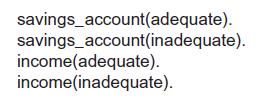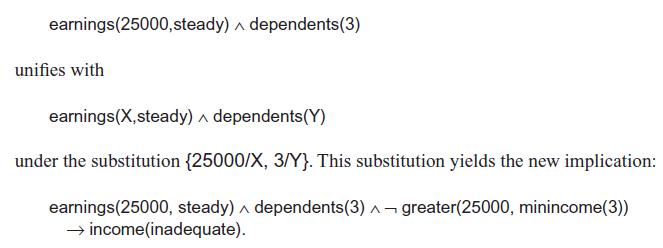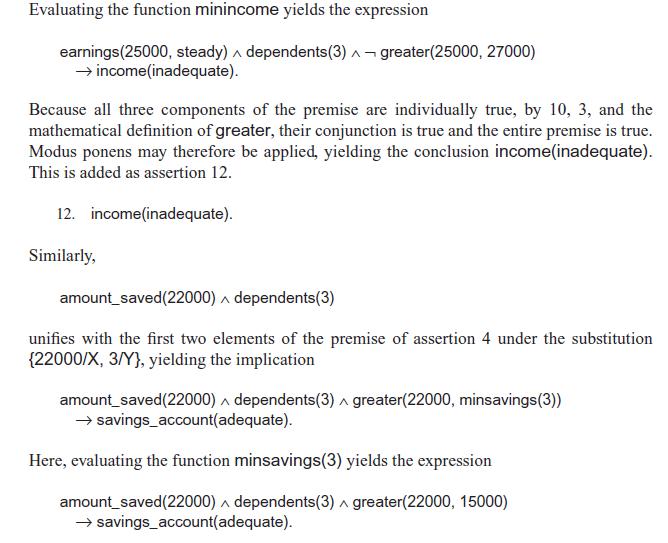Take the logic-based financial advisor of Section 2.4, put the predicates describing the problem into clause form,
Question:
Take the logic-based financial advisor of Section 2.4, put the predicates describing the problem into clause form, and use resolution refutations to answer queries such as whether a particular investor should make an investment(combination).
Data from section 2.4
As a final example of the use of predicate calculus to represent and reason about problem domains, we design a financial advisor using predicate calculus. Although this is a simple example, it illustrates many of the issues involved in realistic applications.
The function of the advisor is to help a user decide whether to invest in a savings account or the stock market. Some investors may want to split their money between the two. The investment that will be recommended for individual investors depends on their income and the current amount they have saved according to the following criteria:
1. Individuals with an inadequate savings account should always make increasing the amount saved their first priority, regardless of their income.
2. Individuals with an adequate savings account and an adequate income should consider a riskier but potentially more profitable investment in the stock market.
3. Individuals with a lower income who already have an adequate savings account may want to consider splitting their surplus income between savings and stocks, to increase the cushion in savings while attempting to increase their income through stocks.
The adequacy of both savings and income is determined by the number of dependents an individual must support. Our rule is to have at least $5,000 in savings for each dependent. An adequate income must be a steady income and supply at least $15,000 per year plus an additional $4,000 for each dependent.
To automate this advice, we translate these guidelines into sentences in the predicate calculus. The first task is to determine the major features that must be considered. Here, they are the adequacy of the savings and the income. These are represented by the predicates savings_account and income, respectively. Both of these are unary predicates, and their argument could be either adequate or inadequate. Thus,

are their possible values. Conclusions are represented by the unary predicate investment, with possible values of its argument being stocks, savings, or combination (implying that the investment should be split). Using these predicates, the different investment strategies are represented by implications. The first rule, that individuals with inadequate savings should make increased savings their main priority, is represented by:
![]()
Similarly, the remaining two possible investment alternatives are represented by:

Next, the advisor must determine when savings and income are adequate or inadequate.
This will also be done using an implication. The need to do arithmetic calculations requires the use of functions. To determine the minimum adequate savings, the function minsavings is defined. minsavings takes one argument, the number of dependents, and returns 5000 times that argument. Using minsavings, the adequacy of savings is determined by the rules:

In these definitions, amount_saved(X) and dependents(Y) assert the current amount in savings and the number of dependents of an investor; greater(X,Y) is the standard arithmetic test for one number being greater than another and is not formally defined in this example. Similarly, a function minincome is defined as:
![]()
minincome is used to compute the minimum adequate income when given the number of dependents. The investor’s current income is represented by a predicate, earnings.
Because an adequate income must be both steady and above the minimum, earnings takes two arguments: the first is the amount earned, and the second must be equal to either steady or unsteady. The remaining rules needed for the advisor are:

In order to perform a consultation, a description of a particular investor is added to this set of predicate calculus sentences using the predicates amount saved, earnings, and dependents. Thus, an individual with three dependents, $22,000 in savings, and a steady income of $25,000 would be described by: amount saved (22000). earnings (25000, steady). dependents (3). This yields a logical system consisting of the following sentences:

![]()
This set of logical sentences describes the problem domain. The assertions are numbered so that they may be referenced in the following trace. Using unification and modus ponens, a correct investment strategy for this individual may be inferred as a logical consequence of these descriptions. A first step would be to unify the conjunction of 10 and 11 with the first two components of the premise of 7; i.e.,


Again, because all of the components of the premise of this implication are true, the entire premise evaluates to true and modus ponens may again be applied, yielding the conclusion savings_account(adequate), which is added as expression 13.
13. savings_account(adequate). As an examination of expressions 3, 12, and 13 indicates, the premise of implication 3 is also true. When we apply modus ponens yet again, the conclusion is investment(combination), the suggested investment for our individual.
This example illustrates how predicate calculus may be used to reason about a realistic problem, drawing correct conclusions by applying inference rules to the initial problem description. We have not discussed exactly how an algorithm can determine the correct inferences to make to solve a given problem or the way in which this can be implemented on a computer. These topics are presented in Chapters 3, 4, and 6.
Step by Step Answer:

Artificial Intelligence Structures And Strategies For Complex Problem Solving
ISBN: 9780321545893
6th Edition
Authors: George Luger





